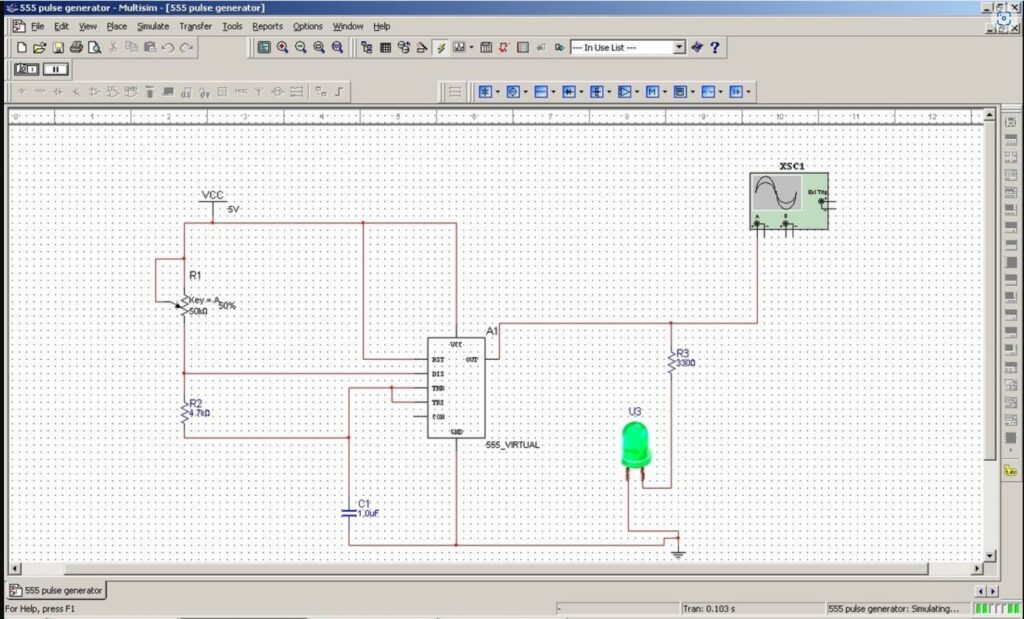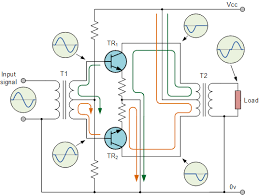Class AB amplifiers represent a critical intersection in the world of electronics, balancing the efficiency of Class B amplifiers with the linearity and low distortion of Class A amplifiers. This hybrid approach makes Class AB amplifiers a popular choice in various applications, particularly where efficiency and sound quality are paramount. This article explores the fundamentals of Class AB amplifiers, their applications, and the reasons for their widespread use, alongside a discussion of their advantages and disadvantages.
Understanding Class AB Amplifiers
Class AB amplifiers combine the characteristics of Class A and Class B amplifiers. In a Class A amplifier, the output transistors conduct throughout the entire signal cycle, ensuring linearity but at the cost of efficiency, as significant power is dissipated as heat. Class B amplifiers improve efficiency by splitting the signal cycle between two transistors: one conducts during the positive half-cycle, and the other during the negative half-cycle. However, this approach can introduce crossover distortion at the point where the two halves of the signal meet.
Class AB amplifiers mitigate the drawbacks of both classes by slightly biasing the output transistors to conduct just beyond the zero-crossing point. This configuration ensures that both transistors are partially on during the transition between the positive and negative halves of the signal, thereby reducing crossover distortion while still maintaining better efficiency than Class A amplifiers.
The following is a simple class AB amplifier where the two diodes in series provide that minimal bias voltage to keep the transistors right on the threshold to be fully on, so to eliminate the distortion caused in class B amplifiers.
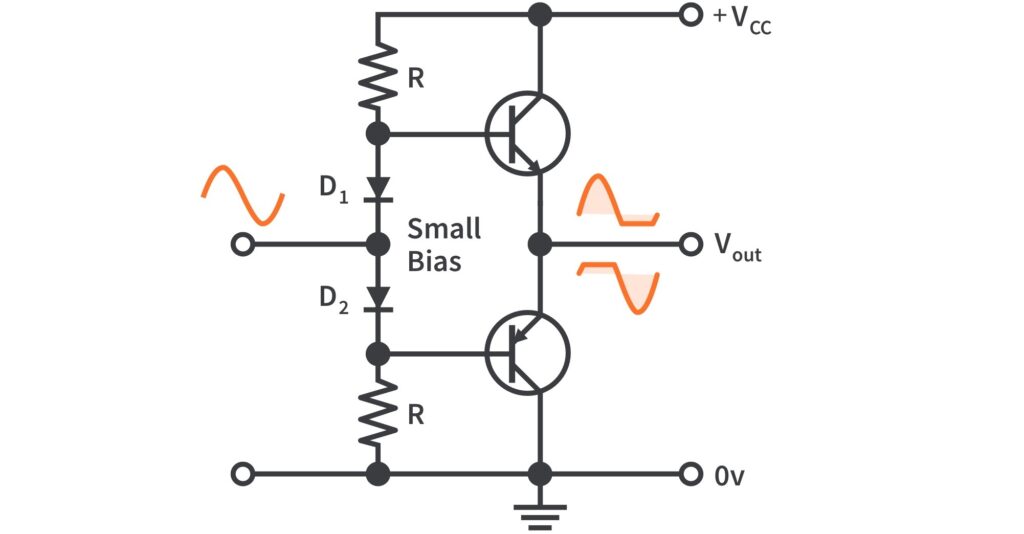
Or the following with coupling capacitors. As you see the diodes are providing 0.7 volts each to keep the transistors just at the threshold of firing when the input signal switches polarities turning one transistor fully on, and the other one on standby, but not completely off, so when the signal switches direction, there won’t be any waste of time to turn the transistor on hence causing the distortion we experienced in class B amplifiers.
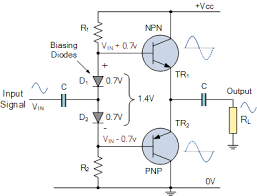
Applications of Class AB Amplifiers
- Audio Amplifiers: One of the most common applications of Class AB amplifiers is in audio amplification. Their ability to provide high fidelity with relatively low distortion makes them ideal for use in home audio systems, professional sound equipment, and musical instrument amplifiers.
- Broadcast Transmitters: In the realm of broadcast transmitters, particularly in FM and AM broadcasting, Class AB amplifiers are favored for their balance of efficiency and linearity, which is crucial for maintaining signal integrity over long distances.
- Power Amplifiers in Wireless Communication: Class AB amplifiers are also employed in power amplifiers for wireless communication devices, where efficient power usage is essential to prolong battery life while ensuring clear signal transmission.
- Servo Motor Drivers: In industrial and automotive applications, Class AB amplifiers are used to drive servo motors, where precise control and efficiency are necessary.
Why and Where Class AB Amplifiers are Used
Class AB amplifiers are chosen for applications that require a compromise between the high fidelity of Class A amplifiers and the efficiency of Class B amplifiers. They are particularly useful in scenarios where:
- Low Distortion is Crucial: The slight conduction overlap in Class AB amplifiers helps minimize the crossover distortion typical in Class B designs, making them suitable for high-quality audio applications.
- Efficiency is a Concern: While not as efficient as Class B amplifiers, Class AB designs are more power-efficient than Class A amplifiers, making them a good choice when both sound quality and power consumption are considerations, such as in battery-operated devices.
- Heat Management is Important: Class AB amplifiers generate less heat than Class A amplifiers due to their improved efficiency, making them easier to integrate into compact devices where thermal management is a challenge.
Advantages of Class AB Amplifiers
- Reduced Crossover Distortion: By keeping both transistors slightly on during the zero-crossing point, Class AB amplifiers significantly reduce the crossover distortion that plagues Class B amplifiers.
- Better Efficiency than Class A: While Class AB amplifiers are not as efficient as Class B amplifiers, they offer a good compromise, consuming less power and generating less heat than Class A amplifiers.
- Good Linearity: Class AB amplifiers maintain a good balance between linearity and efficiency, which is essential in applications requiring high-fidelity signal reproduction.
- Versatility: These amplifiers are versatile, making them suitable for a wide range of applications, from audio amplification to wireless communication and beyond.
Disadvantages of Class AB Amplifiers
- Complexity in Design: The design of Class AB amplifiers is more complex than that of Class A or Class B amplifiers, requiring careful biasing to minimize distortion and ensure efficiency.
- Less Efficient than Class B: While more efficient than Class A amplifiers, Class AB designs are still less efficient than pure Class B amplifiers, which may be a drawback in power-critical applications.
- Potential for Thermal Instability: The need to bias the transistors can lead to thermal instability, as variations in temperature can affect the bias point, potentially leading to increased distortion or even damage if not properly managed.
Conclusion
Class AB amplifiers offer a well-rounded solution for applications where both sound quality and power efficiency are important. Their ability to reduce crossover distortion while maintaining good efficiency makes them a popular choice in audio amplification, broadcast transmitters, and various communication devices. However, their design complexity and potential for thermal issues require careful consideration and expertise in implementation. Despite these challenges, the versatility and performance of Class AB amplifiers ensure their continued relevance in the ever-evolving field of electronics.
Ready to take a dive into Electrical Engineering to get a head start on College or University, or simply expand your DIY knowledge?
Check out our meticulously designed course in Electrical/Electronic Engineering for all walks of life, from any country. Delivered by Professor F. Tavassoli.
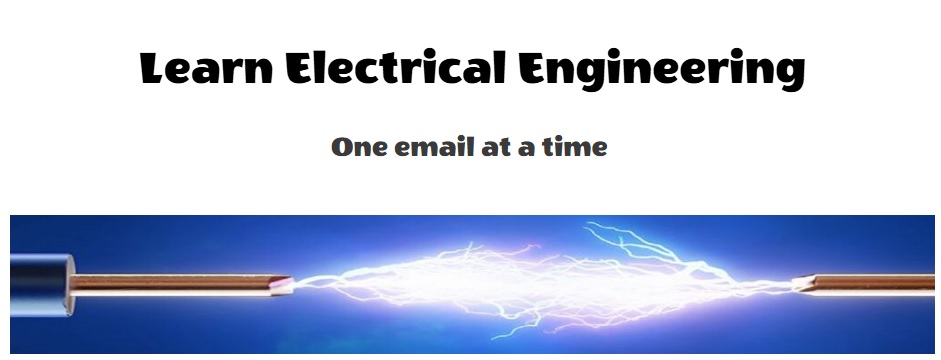
Join students and professionals
from across the world increasing their knowledge of Electrical Engineering.
One email at a time
We never send spam or give your information to anyone, Privacy Policy here.

